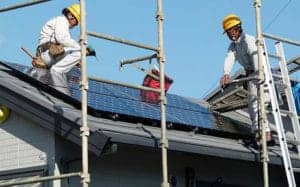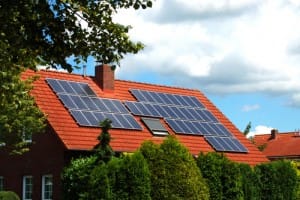by Theresa Coleman and Paul Kangas
In the week before the March 11, 2011, earthquake at Fukushima, one person, Prime Minister Naoto Kan, did an extraordinary act that set Japan’s energy course in history for the next 100 years.

He was able to convince the Japanese Parliament to pass a solar payment policy (SPP), that required big utilities in Japan to pay solar home owners $0.53 kwh for 20 years.
This is amazing. One, because the rate is very attractive to solar home owners and two, because he even made the effort.
This one policy shift is now making Japan one of the leading solar powered nations on earth – far ahead of California or the U.S.
Number one in solar generation in 2014 was Germany. The same year they won the World Cup in soccer. They are on a roll.
It is going to be interesting to see if China becomes No. 2 in 2015. It is a tight three-way race between Japan, Germany and China. Who will win?
The really big question is: “What inspired Prime Minister Naoto Kan to introduce this solar payment policy to the Japanese Parliament the day before Fukushima? Was it Chernobyl?
Apparently Kan had read the book “Solar Economy” by Hermann Scheer the year before. It got him to thinking about how solar policy could actually be drafted to shut down all the nuclear power plants in Japan over the next 50 years.
Scheer had written his book as his response to Chernobyl. Scheer became convinced that every city in Germany could be powered 100 percent by wind, water and solar.
Scheer had built himself a solar powered home in 1981, so he knew the science worked. Then, when Chernobyl happened, Scheer went to work convincing his colleagues in the Parliament that Germany could actually shut down all their nukes, by first building 100,000 solar powered homes. The rest is history – the history of this solar revolution now sweeping the world.
This one policy shift is now making Japan one of the leading solar powered nations on earth – far ahead of California or the U.S. Number one in solar generation in 2014 was Germany.
Little did Kan realize that what would happen within hours of Parliament passing the solar policy, on that fateful day four years ago, March 11, 2011, would forever change the course of history for Japan and the whole world.
Sounds impossible, right: Japan going 100 percent solar? Does that seem possible to you in 2015? Most people, who don’t understand the power of the sun, still think Japan going 100 percent solar is insanely impossible.
What do you think? Would you put 100 solar panels on your home?
Since Chernobyl, 1986, many thinkers worldwide have been watching Germany shut down one nuke after another. Kan too was impressed by this, especially after he read the book “Solar Economy.” Have you read that book?
Germany and Japan had both been banned from having a military after World War II, so they were able to save more money and use their national income to develop schools, mass transit, car production etc. By spending millions on schools and training a new generation as architects, engineers and policy makers, Japan and Germany could leap far ahead of the U.S. education system and the U.S. solar industry. Education works.
Japan and Germany had little oil on their land, so they both had developed a keen interest in solar and wind.
In the ‘50s, the U.S. forced Japan to accept atomic reactors. The majority in Japan hated atomic energy because of Nagasaki and Hiroshima.
But the U.S. corporations, especially GE, and the U.S. military attacked the Japanese anti-nuke movement viciously, in a hundred ways, and politically forced Japan to install 50 GE nuclear power plants across Japan.
This created a great anger in the majority. Many engineers turned their anger into developing solar energy.
All these factors combined to inspire Naoto Kan, a pro-solar and anti-nuke activist, to ask the Japanese Parliament on March 11, 2011, to require the big utilities to pay solar home owners a premium for selling solar onto the grid.
His original vision was, “The transition to solar and wind would take maybe 50 years.”
Kan made the Parliament an offer they couldn’t refuse: He offered to resign, fugitively, “to fall on his sword” if they would pass the solar payment policy for Japan. Many in the Parliament hated Kan because of his pro-solar policies.
The Parliament saw the SPP as “nothing more than a minor greenie project,” “a Girl Scout project that would have no impact on nuclear energy.” “It was “too small, too girlish, too weak, too little to do any good.”
That might have been true in normal times. But history was moving inevitably towards solar, wind, water and renewables. Fukushima just moved the needle faster.
Hours after the SPP passed, Fukushima happened. Boom, boom, boom! Three reactors exploded and melted down.
Now, in 2015, the three atomic cores are still melting down into the earth beneath Japan, creating the gravest crisis on earth. And for the most part, the U.S. media works hard to ignore reporting any news about the fact that the three atomic cores are still melting.
If you want to understand how the coverup of this crisis is still being pushed by the U.S. and Japanese media, watch the movie “China Syndrome,” starring Jane Fonda. That movie was made the month before Three Mile Island exploded. That movie could not be made today. Corporate censorship in the U.S. would never allow such a movie to be made, even today.
Suddenly, after Fukushima, all the nukes in Japan had to be shut down. Suddenly the people’s movement for solar saw an opening, a way to get rid of nukes using solar. A mass solar movement erupted of home owners installing millions of solar panels in the next four years.
Still today, in 2015, every Friday, 100,000 people march on the prime minister’s house, demanding Japan go 100 percent solar and all the nukes be kept shut down. Every Friday.
The U.S. media rarely reports on the huge marches by this pro-solar, anti-nuke movement in Japan. Now, four years later, all the nukes are still shut down …. and the lights are still on.
Why? Because the people’s solar movement has worked every day to install millions of solar panels everywhere in Japan. It is working.
Suddenly, after Fukushima, all the nukes in Japan had to be shut down. Suddenly the people’s movement for solar saw an opening, a way to get rid of nukes using solar. A mass solar movement erupted.
Japan is following Germany towards becoming a 100 percent solar powered nation by 2041.
What great leap forward can come from the human race working together to solve Fukushima? We all must focus on building more solar homes in San Francisco, in California, nationwide, and in Japan.
Towards this end, we in San Francisco have held a rally on the 11th of every month for the last three years at the Japanese Consulate, 275 Battery and Sacramento, at 3 p.m., to encourage Japan to build more solar powered homes. Please join us.
Japan is following Germany towards becoming a 100 percent solar powered nation by 2041.
Yes, the three reactors at Fukushima are still spewing deadly radioactive water into our once peaceful Pacific Ocean.
As long as we are alive and still able to struggle to get control of this mess we created for the next generation, we must act daily to try and find a long term solution. Before we die, we need to save our green planet for our children.
Our job is to do the impossible. Collectively, we all have answers to the climate emergency. If we each raise better ideas daily, we will eventually come up with a better solution.
Can major cities like Tokyo be powered 100 percent from solar and wind? That is the question.
As of 2015, Germany has 109 small towns that are 100 percent solar and wind powered. Germany has said they will shut down all their nukes by 2022. They seem to be on track to do that.
Prime Minister Angela Merkel, with a degree in physics, was elected as pro-nuke. After she watched Fukushima melt down, she became convinced that Germany can become 100 percent solar and renewable powered. She switched sides. Are women more flexible than men? Do we need a woman president?
It is inevitable that every city can become 100 percent solar and renewable. We know that is our destiny.
In some ways, the battle to save Fukushima is the battle to save the world from nukes. Hermann Scheer created the policy tools we need to shut down all nukes by shifting every city to 100 percent solar.
If a poll was done in every country in the world today, probably the two nations where a majority would agree that every city can go 100 percent solar and wind, would be Japan and Germany – thanks to Scheer. Naoto Kan adopted Scheer’s ideas and began his crusade in Japan. Scheer passed the torch onto Kan.
Kan introduced the solar payment policy in Japan in 2011. Then Fukushima made that solar policy permanent in Japan.
Japan shut down all its nukes and yet the lights stayed on.
I predict, because solar is rising so rapidly in the land of the rising sun, that Japan will never restart any of its nukes – even though the U.S. media is demanding Japan restart one of its nukes. Let us pray that the solar home owners in Japan win this race against nuclear power. Our lives too depend on solar winning.
German Prime Minister Angela Merkel, watching the Fukushima meltdown on TV, immediately adopted the solar payment policy as her own and vowed to continue the shutdown of all nukes in Germany. All the nukes will be closed by 2022, according to the governor of Badden, Herr Kersner, whom Paul Kangas interviewed in June 2014.
We, the people of California, need to understand that, if any state can go 100 percent solar and wind, now in 2015, it can be California. California could be the first solar state in the U.S. because we have a governor who supports the solar payment policy and so signed AB 327 for a solar feed in tariff. We just need to push Gov. Jerry Brown more.
Every piece of the puzzle is in place for California to become 100 percent solar, wind and tidal powered by 2041. All we need now is five activists in each city to ask their city council to make it happen.
We, the people of California, need to understand that, if any state can go 100 percent solar and wind, now in 2015, it can be California.
If Berkeley city council would pass a solar payment policy, that would create a big push for every city to go solar, and so the state. Whatever way Berkeley goes, so goes the state.
I pray you who read this will embrace the solar payment policy as your torch to freedom as tightly as have Naoto Kan, Angela Merkel and millions around the world. How can you start? Build one home in your city with 100 solar panels. Can you do it? Yes!
Community advocate Theresa Coleman and solar energy advocate Paul Kangas can be reached at theresalynncoleman@yahoo.com and dr8kangas@me.com, respectively.






